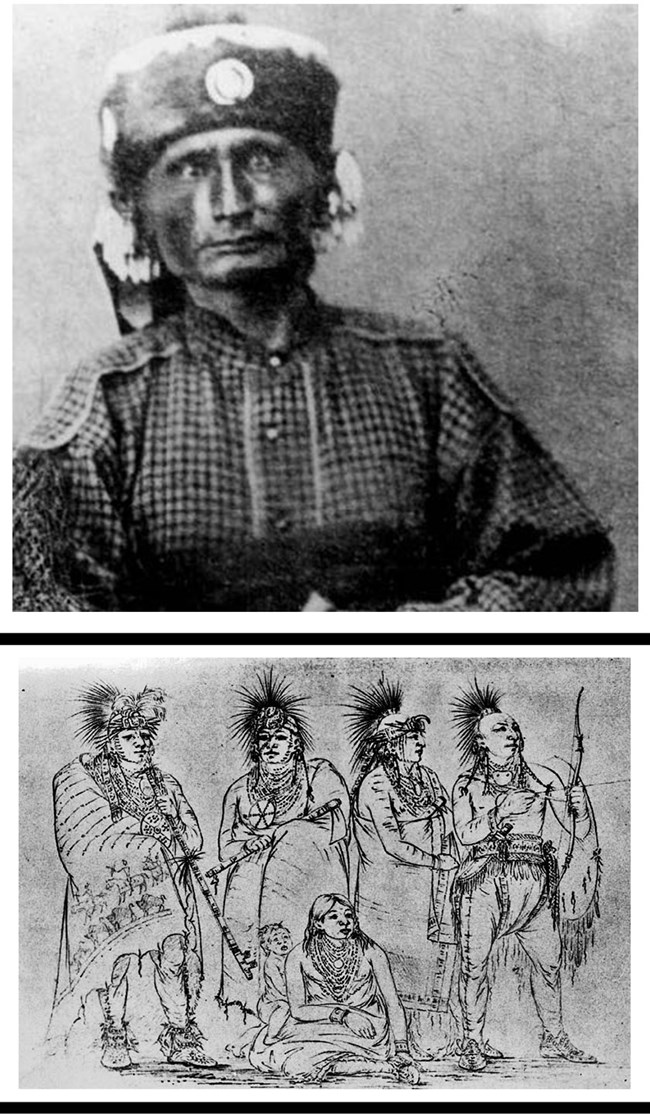Last updated: March 17, 2021
Article
Flint Hills First Peoples

NPS

NPS/KSHS
The Kansa
As westward expansion continued across North America, the Kansa, Kaw, or “People of the Southwind” had already established themselves in what would later becomethe state of Kansas. Earlier treaties with the United States, the Kansa, saw the establishment of the Santa Fe Trail, increasing travel and settlement. As a result, the Kaw were removed to reservation lands near Council Grove, KS in 1847. Less than 30 years later, over the objections of Kansa Chief Al-le-ga-wa-ho, the Kansa were removed from Kansas to what would later become the state of Oklahoma, where they live today as the Kaw Nation of Oklahoma.
NPS/KSHS
Sharing the Land
The Flint Hills were at one time a communal bison hunting ground for the Pawnee, Osage, Wichita, and Kansa, who knew that the area was good grazing ground for bison. Using the abundant flint, or chert, found close to the surface, arrowheads and other tools could be made by knapping the stone, striking it to form sharp edges on the resulting pieces.
NPS/KSHS
Living with the Land
Being keen observers of their environment out of necessity, these Native peoples saw that bison and other grazing animals were attracted to the tender, new plant life that grew immediately after lightning had set vast grass fires. They adapted this natural process to attract bison and other grazing animals to their Flint Hills hunting grounds by setting grass fires of their own and waiting for bison and other grazing animals to find the tender, new plant life.In some ways, the lifestyles of the native peoples of the Flint Hills region and the incoming American settlers shared remarkable similarities. For example, both peoples established stable populations near water sources. The incoming settlers took up the Native practice of using fire to improve plant growth and encourage grazing by their cattle herds. And finally, both peoples cultivated gardens and croplands as additional food sources. However, their similarities were dramatically overshadowed by their differences, often resulting in misunderstanding and violent confrontation.

NPS/KSHS
Early Explorers
Early tallgrass prairie explorers encountered what was to them a unique and intimidating landscape. Spaniard Francisco Vasquez de Coronado was one of the first Europeans to describe in written records the interior of North America, exploring into what is now central Kansas in the middle 1500s. Not finding large cities of gold and other riches in North America’s interior, Spain moved south and west into what is now Mexico, bringing not only the Spanish language, but also horses, cattle, and the foundations of cattle culture to North America.American explorer Zebulon Pike inadvertently coined the term “Flint Hills.” Passing through the area in September 1806, ten miles south of the present day park, he made this journal observation: “Passed very ruff flint hills. My feet blistered and very sore.”
Today, “Flint Hills” refers to a large area of east central Kansas encompassing around 20- 25% of the state. Although the Flint Hills supports a wide diversity of plants and animals, early settlers were unaccostomed to its ways and refered to it as part of the “Great American Desert.”
